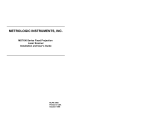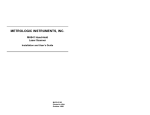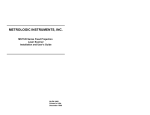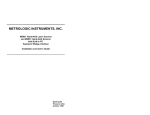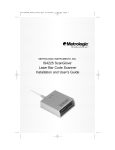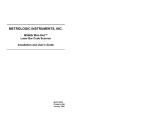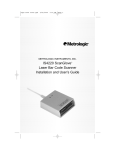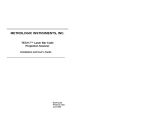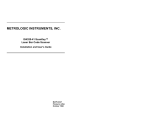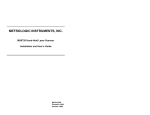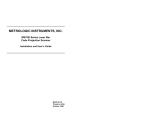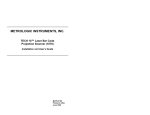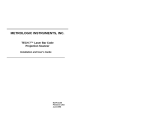Download Metrologic IS421X ScanGlove User`s guide
Transcript
METROLOGIC INSTRUMENTS, INC. IS421X ScanGlove® Laser Bar Code Scanner Installation and User’s Guide MLPN 2187 Printed in USA October 1998 Locations: USA Corporate Headquarters Metrologic Instruments, Inc. 90 Coles Road Blackwood, NJ 08012 Customer Service: 1-800-ID-METRO Tel: 609-228-8100 Fax: 609-228-6673 [email protected] www.metrologic.com Europe Metrologic Instruments GmbH Dornierstrasse 2 82178 Puchheim b. Munich, Germany Tel: 49-89-89018-0 Fax: 49-89-89019-200 [email protected] ASIA Metrologic Asia (PTE) Ltd. 31, Kaki Bukit Road 3 #05-08 Techlink Singapore 417818 Tel: 65-842-7155 Fax: 65-842-7166 [email protected] South America Metrologic Instruments Rua Flórida, 1.821-5°Andar-Brooklin CEP 04571-090, São Paulo-SP, Brasil Outside Brazil: Tel: 55-11-5505-6568 Fax: 55-11-5505-1681 [email protected] In Brazil: Tel: 55-11-5505-2396 Fax: 55-11-5507-2301 [email protected] Copyright © 1998 by Metrologic® Instruments, Inc. All rights reserved. No part of this work may be reproduced, transmitted, or stored in any form or by any means without prior written consent, except by reviewer, who may quote brief passages in a review, or provided for in the Copyright Act of 1976. Products and brand names mentioned in this document are trademarks of their respective companies. ii Table of Contents Introduction . . . . . . . . . . . . . . . . . . . . . . . . . . . . . . . . . . . . . . . . . . . . . . . . . . . 1 Unpacking List . . . . . . . . . . . . . . . . . . . . . . . . . . . . . . . . . . . . . . . . . . . . . . . . . 1 Theory of Operation . . . . . . . . . . . . . . . . . . . . . . . . . . . . . . . . . . . . . . . . . . . . . 2 Connecting the IS4210 or IS4213 ScanGlove to a Decoder/Controller . . . . . 3 Parts of the ScanGlove Scanner . . . . . . . . . . . . . . . . . . . . . . . . . . . . . . . . . . . 4 Audible Indications . . . . . . . . . . . . . . . . . . . . . . . . . . . . . . . . . . . . . . . . . . . . . 5 Visual Indications . . . . . . . . . . . . . . . . . . . . . . . . . . . . . . . . . . . . . . . . . . . . 6-9 Labels . . . . . . . . . . . . . . . . . . . . . . . . . . . . . . . . . . . . . . . . . . . . . . . . . . . . . . . 10 IR Sensor Activation . . . . . . . . . . . . . . . . . . . . . . . . . . . . . . . . . . . . . . . . . . . 11 Scan Field . . . . . . . . . . . . . . . . . . . . . . . . . . . . . . . . . . . . . . . . . . . . . . . . . . . 11 Depth of Field and Symbol Specification . . . . . . . . . . . . . . . . . . . . . . . . . . . 12 Maintenance . . . . . . . . . . . . . . . . . . . . . . . . . . . . . . . . . . . . . . . . . . . . . . . . . . 13 Appendix A Specifications . . . . . . . . . . . . . . . . . . . . . . . . . . . . . . . . . . . . . . . . . 14 Appendix B IS4210 and IS4213 Pin Assignments . . . . . . . . . . . . . . . . . . . . 15, 16 IS4215 Pin Assignments . . . . . . . . . . . . . . . . . . . . . . . . . . . . . 17, 18 Appendix C Warranty and Disclaimer . . . . . . . . . . . . . . . . . . . . . . . . . . . . . 19, 20 Appendix D Notices . . . . . . . . . . . . . . . . . . . . . . . . . . . . . . . . . . . . . . . . . . . 21, 22 Appendix E Patents . . . . . . . . . . . . . . . . . . . . . . . . . . . . . . . . . . . . . . . . . . . . . . . 23 Index . . . . . . . . . . . . . . . . . . . . . . . . . . . . . . . . . . . . . . . . . . . . . . . . . . . . 24, 25 iii Introduction The ScanGlove™ non-decode scanners interface directly into decode equipped "keyboard wedges," controllers, or decode, they are designed distinctly to accommodate many types of applications. When using the ScanGlove™ with a decoder, scanner operation is dependent upon your decoder. Since there are many decoders available, refer to the decoder’s documentation concerning scanner requirements and operation. Unpacking List With the purchase of a ScanGlove scanner, the following will be in the shipping carton: ! ! ! Installation and User’s Guide ScanGlove Laser Bar Code Scanner Glove To order additional items, contact your dealer, distributor or call Metrologic’s Customer Service Department. 1 Theory of Operation When connected to a decoder/controller and to the signals as defined in the pin assignment sections, the IS4210 and IS4213 scanners will operate as follows. The scanning process initiates by an infrared (IR) device located behind the window. The IR sensor is active as long as the power is applied to the unit. When the IR sensor detects an object, the green LED will flash. When the laser decodes a bar code, the scanner transmits the data to the host system and then " beeps" to show the decoding is complete. The IR sensing range can be programmed for two ranges. Short Range Activation - The IR signal initiates the scan process if it senses an object anywhere from the face of the window out to approximately 4" to 7". Long Range Activation - The IR signal initiates the scan process if it senses an object anywhere from the face of the window out to approximately 9" to 13". If the object is removed from the field during the scanning process, the laser turns off and the scanner reenters "standby" mode. However, if the object stays in the field, the laser remains on for up to 2.5 seconds trying to detect another bar code. If the scanner does not detect a bar code, the scanner reenters "standby" mode. To reactivate the scanning sequence, remove the object and present another. If the same symbol stays in the field after a successful scan, the laser stays on for approximately 4 seconds and then turns off. This prevents uninten-tional reads of the same bar code. To read the same symbol more than once, remove the object from the scan field for approximately 1 second and then present the symbol again. 2 Connecting the IS4210 or IS4213 ScanGlove to a Decoder/Controller Important Note: To maintain compliance with applicable standards, all circuits connected to the scanner must meet the requirements for SELV (Safety Extra Low Voltage) according to EN 60950. Since each host system is unique, configure the decoder/controller to match your host system requirements. Refer to the Installation and User’s Guide for further information. Since there are many different types of decoders, refer to your decoder’s documentation to connect the decoder to your host system. 1. Make sure the host system is off and the ON/OFF toggle switch on the controller is in the OFF (O) position. 2. Connect the 9-pin squeeze end of the scanner adaptor cable to the decoder/ controller. Then, attach the 15-pin connector of the host’s communication cable to the decoder/controller. Connect the other end of the cable to the host device. 3. If the decoder/controller receives power from an external power supply, check the AC input requirements of the transformer/power supply to make sure the voltage matches an available AC outlet. Connect the power supply to the decoder/controller. (The socket-outlet can be installed near the equipment so it will be easily accessible.) 4. Supply power to the scanner and decoder/controller by plugging the power supply into the AC outlet. Position the decoder ON/OFF switch to the ON (1) position and then power up the host system. Note: When the ScanGlove first receives power, it will immediately go through a self diagnostic routine, then the red and green LED will flash and the unit will beep once. When positioning the ScanGlove, make sure to align the output window flush with the knuckles of your hand. Also, avoid obstructing the output window. Rings and fingers may prevent the scanner from reading a bar code. 3 Parts of the ScanGlove Scanner Becoming familiar with the features of the scanner will help when operating the scanner. The following illustration and list explain the pertinent parts. Figure 1 Green and Red LED When the red LED is on, this shows that the laser is on. Depending upon your decoder, when the green LED flashes on, this shows that the scanner has read a bar code successfully. When the green light turns off, communication to the host is complete. Output Window Sends and receives the IR signal and Laser beam. Infrared Object Sensor If a specified time has elapsed without any scanning, the unit will enter a “standby” mode. To reactivate the unit, point the output window downwards or wave an object in front of the IR (infrared) sensor. When the red LED comes on, the scanner is ready to scan. Head Cable This cable terminates to the specifications of each order. 4 Audible Indicators Audible indicators show the status of the scanner. These indicators are dependent upon the decoder being used. The function of these indications may not work as described below if the decoder pinouts and software controls do not match the pin out signals as defined in the pin assignment section of this manual. To change the volume (four settings are available) or turn the beeper off, refer to the Programming Guide section: Beeper Tones. One Beep When the scanner first receives power, the red LED will blink, followed by the green LED, and then the scanner will "beep." After the scanner performs this start-up sequence, the scanner is ready to scan. When the scanner successfully reads a bar code, the green light will flash and "beep" once. If the scanner does not "beep" or the green LED does not flash then the bar code read is not successful. Razzberry Tone If, upon power up, the scanner emits a razzberry tone, then the scanner has failed diagnostics. Note: The scanner can be programmed to emit a razzberry tone when the timeout occurs during communication between the host and scanner. Refer to the Programming Guide section: Audible Indicators for Communication Timeouts. 5 Visual Indicators There are visual indicators to show the status of the scanner. These indicators are dependent upon the decoder being used. The function of these indicators may not work as described below if the decoder pinouts and software controls do not match the pin out signals as defined in the pin assignment section of this manual. There are a red LED and a green LED at the top of the scanner. When the scanner is on, the flashing or steady activity of the LEDs indicates the status of the scan and scanner. No Red or Green Illumination of the LEDs will not occur if the scanner has remained dormant for a specified time and the scanner is not receiving power from the host. To reactivate the unit, direct the output window up then down toward the object. Red Flash; Green Flash; Steady Red When the scanner first receives power, the red LED will flash, followed by the green LED, and then "beep" once. After the scanner performs this startup sequence, the red LED will remain on for a specified time showing that the scanner is ready to scan. If an object is not presented to the scanner, the red light will turn off. Steady Red When the laser is on, the red LED will be on. This occurs when an object is in the scan field. If the scanner cannot detect a bar code within approximately 2.5 seconds, the red LED will shut off indicating that the laser is no longer on. Steady Red; Green Flash When the scanner successfully reads a the scanner does not bar code, the green LED will flash and "beep" once. If "beep" or the green LED does not flash then the bar code read is not successful. Repetitive Red Flashes When the red LED flashes several times while it rests upon a stationary surface, then an object is within the scan field and is activating the IR sensor. To eliminate this disturbance, direct the scan window toward a different location. 6 Signaux optiques Il existe des signaux optiques qui vous informent sur l'état du scanner. Ces signaux dépendent du décodeur que vous utilisez. Il peut arriver que les fonctions de ces signaux ne correspondent pas à celles qui suivent si vous utilisez un décodeur qui n'a pas été construit par Metrologic. Sur la partie supérieure du scanner se trouvent une diode LED rouge et une diode LED verte. Les diodes rouge et verte clignotantes ou allumées vous informent sur l'état de palpage et de scanner. Ni la diode rouge, ni la diode verte n'est allumée Il arrive fréquemment que les deux diodes ne s'allument pas. Pour deux raisons. Les diodes ne s'allument pas quand le scanner ne reçoit de l'énergie ni de l'ordinateur central, ni du transformateur. Quand le scanner reçoit de l'énergie et ne s'allume cependant pas, le scanner est resté pendant une certaine période sansêtre utilisé et le laser et le moteur sont désactivés. Pour réactiver l'unité, déplacer un objet devantle palpeur infrarouge ou prendre le scanner et diriger la fenêtre de palpage vers le bas. Diode rouge clignotante; diode verte clignotante; diode rouge restant allumée Quand le scanner reçoit pour la première fois de l'énergie, la diode rouge se met d'abord à clignoter, puis la diode verte. Ensuite, le scanner émet un bip sonore unique. Une fois cette séquence de démarrage effectuée, la diode rougereste allumée pendant un certain temps indiquant que le laser est prêt à servir. Quand le scanner nedétecte aucun objet, la diode rouge s'éteint. Diode rouge restant allumée Quand un objet se trouve devant la fenêtre de palpage, la diode rouge reste allumée et indique que le scanner est prêt à servir. Diode rouge restant allumée; diode verte clignotante Après lecture avec succès d'un code barres par le scanner, la diode verte se met à clignoter, suivie d'un bip sonore unique. Si la diode vertene clignote pas ou quand aucun bip sonore n'est émis, cela signifie que le code barres n'a pas pu être lu avec succès. Clignotement répété de la diode rouge Quand la diode rouge clignote plusieurs fois pendant que l'appareil repose sur une surface non déplacée, un objet activant le palpeur infrarouge setrouve devant la fenêtre de palpage. Ceci peut se produire même quand le scanner se trouve sur une table ou un reposoir. Pour éliminer ce défaut, positionner le scanner de façon différente. 7 Optische Anzeigen Es sind optische Anzeigen vorhanden, die Ihnen Aufschluß über den Scannerstatus geben. Diese Anzeigen sind abhängig von dem von Ihnen verwendeten Dekodierer. Es kann sein, daß die Funktionen dieser Anzeigen nicht den nachfolgend angegebenen entsprechen, falls Sie einen Dekodierer verwenden, der nicht von Metrologic hergestellt wurde. Auf der Oberseite des Scanners befinden sich zwei Leuchtdiodenanzeigen: eine rote und eine grüne. Die blinkenden bzw. feststehenden Leuchtdiodenanzeigen geben Aufschluß über den Abtast- und Scannerstatus. Weder rote noch grüne Leuchtanzeige Es kommt häufig vor, daß die beiden Leuchtdiodenanzeigen nicht aufleuchten. Dafür gibt es zwei mögliche Gründe. Die Anzeigen leuchtennicht, wenn der Scanner weder vom Hostrechner noch vom Transformator Energie erhält. Erhält der Scanner Energie, und die Anzeigen leuchten dennoch nicht auf, so ist der Scanner für einen bestimmten Zeitraum untätig geblieben, und Laser und Motor sind abgeschaltet. Zur Reaktivierung der Einheit sollten Sie ein Objekt vor dem Infrarot-Sensorhin- und herbewegen oder den Scanner aufnehmen und das Abtastfenster nach unten richten. Rote Blinkanzeige; Grüne Blinkanzeige; feststehende rote Leuchtanzeige Wenn dem Scanner erstmalig Energie zugeführt wird, blinkt zunächst die rote Leuchtdiodenanzeige auf, gefolgt von der grünen Leuchtdiodenanzeige, und anschließend sendet der Scanner ein einmaliges Piep-Signal aus. Nach Ausführung dieser Startsequenz leuchtet die rote Leuchtdiodenanzeige für einen bestimmten Zeitraum auf und zeigt an, daß der Scanner zur Durchführung des Scannens bereit ist. Wird dem Scanner kein Objekt präsentiert, so erlischt die rote Leuchtanzeige. Feststehende rote Leuchtanzeige Befindet sich ein Objekt vor dem Ausgabefenster, so leuchtet die rote Leuchtdiode weiterhin auf und zeigt an, daß der Scanner zur Durchführung des Abtastvorgangs bereit ist. Feststehende rote Leuchtanzeige; grüne Blinkanzeige Nach erfolgreichem Lesen eines Barcodes durch den Scanner blinkt die grüne Leuchtdiodenanzeige auf, gefolgt von einem einmaligen Piep-Signal. Falls die grüne Leuchtdiodenanzeige nicht aufblinkt oder der Scanner kein Piep-Signal aussendet, bedeutet dies, daß der Barcode nicht erfolgreichgelesen werden konnte. Wiederholte rote Blinkanzeigen Blinkt die rote Leuchtdiodenanzeige mehrmals auf, während das Gerät auf einer nichtbewegten Fläche liegt, so befindet sich ein Objekt innerhalb des Abtastfeldes, das den Infrarot-Sensor aktiviert. Dies kann selbst dann vorkommen, wenn der Scanner auf dem Ladentisch oder dem Ablagegestell liegt. Um diese Störung zu beseitigen sollten Sie den Scanner anders positionieren. 8 Segnali ottici Sono previsti dei segnali ottici che Vi informano sullo stato dello scanner. Questi segnali dipendono dal decodificatore da Voi utilizzato. Se utilizzate un decodifi-catore che non è stato fabbricato dalla Metrologic è possibile che le funzioni di questi segnali non corrispondano a quelle qui di seguito indicate. Sulla parte superiore dello scanner si trovano due diodi luminosi: uno rosso e uno verde. I diodi luminosi, che possono o essere accesi in continuazione o lampeggiare, Vi informano sullo stato della scansione e dell’apparecchio. Né il diodo luminoso rosso né quello verde sono accesi Succede spesso che i due diodi luminosi non siano accesi. Vi sono due cause possibili. Se lo scanner non viene alimentato né dal calcolatore host né dal trasformatore, i diodi luminosi non sono accesi. Se invece lo scanner viene alimentato e ciònonostante i diodi luminosi non sono accesi, lo scanner è rimasto disattivato per un determinato periodo e laser e motore sono spenti. Per riattivare l’unità dovreste muovere un oggetto davanti al sensore a infrarossi oppure prendere lo scanner e rivolgere il finestrino di scansione verso il basso. Il diodo luminoso rosso lampeggia; il diodo luminoso verde lampeggia; il diodo luminoso verde è acceso Quando lo scanner viene alimentato per la prima volta, lampeggia dapprima il diodo luminoso rosso e quindi quello verde. Poi lo scanner emette un unico segnale beep. Dopo l’esecuzione di questa sequenza di avvio, il diodo luminoso rosso si accende per un determinato periodo ed indica che il laser è pronto per effettuare una scansione. Se allo scanner non viene presentato nessun oggetto, il diodo luminoso rosso si spegne. Il diodo luminoso rosso è acceso Se un oggetto si trova davanti al finestrino di uscita, il diodo luminoso continua ad essere acceso indicando così che lo scanner è pronto per effettuare una scansione. Il diodo luminoso rosso è acceso; il diodo luminoso verde lampeggia Dopo la lettura riuscita di un codice a barre da parte dello scanner il diodo luminoso verde lampeggia e quindi viene emesso un unico segnale beep. Se il diodo luminoso verde non lampeggia oppure lo scanner non emette un segnale beep, ciò significa che la lettura del codice a barre non è riuscita. Il diodo luminoso rosso lampeggia ripetutamente Se il diodo luminoso rosso lampeggia ripetutamente mentre l’apparecchio si trova su una superficie immobile, vi è un oggetto all’interno della zona di scansione che attiva il sensore a infrarossi. Ciò può essere addirittura il caso quando lo scanner si trova sul banco oppure nel suo supporto. Per eliminare questa anomalia basta cambiare la posizione dello scanner. 9 Labels The scanner is a CDRH Class II laser system. The CDRH Class II label and the serial number label are located at the bottom of the unit. The “Avoid exposure laser light emitted from this aperture” label is located directly over the output window. Below are examples of these labels: Caution For the scanner to comply with IEC 825 as a Class 1 laser product, the device used to control the scanner must limit each cycle of operation to a maximum of 3.5 seconds scanning and provide a minimum reaction time of 1 second. 10 IR Sensor Activation The scanning process initiates by an infrared (IR) sensor located behind the output window. In short range mode the signal it projects extends approximately 4" - 7" beyond the output window. In long range mode the signal it projects extends approximately 9" - 13" beyond the output window. The IR sensor remains active as long as power is applied to the unit. The mode wanted can be manually enabled by repositioning the Short Range/Long Range switch that is on the side of the ScanGlove (refer to Figure 2). Short range activation is down; long range activation is up. Figure 2 Scan Field The depth of field for the scanner is 38.1 mm to 139.7 mm (1.5" to 5.5") from the face of the output window (Refer to Figure 3). Figure 3 11 Depth of Field and Symbol Specification (Refer to Figure 4) Code Type* Minimum Small Element Mil. (1/1000") UPC/EAN UPC/EAN Code 39 Code 39 Code 39 I 2 of 5 I 2 of 5 I 2 of 5 Codabar Codabar Codabar Code 128 Code 128 10.4 13.0 7.5 12.0 21.0 7.5 12.0 21.0 6.5 9.8 13.0 7.0 13.0 Code Density Depth of Field 80% 100% High Medium Low High Medium Low High Medium Low 80% 100% 1.5" - 5.5" 1.5" - 6.0" 1.5" - 4.0" 2.5" - 5.5" 3.0" - 6.5" 1.5" - 4.0" 3.0" - 5.5" 2.5" - 6.0" 2.5" - 4.0" 2.0" - 5.0" 2.0" - 6.0" 2.0" - 4.0" 3.0" - 6.0" * All codes printed black on white. Figure 4 12 Maintenance Smudges and dirt can interfere with the proper scanning of a bar code. Therefore, the output window will need occasional cleaning. 1. Spray glass cleaner onto lint free, non-abrasive cleaning cloth. 2. Gently wipe the output window. 13 Appendix A Specifications Application: Light Source: Max. Laser Power: CDRH: UL/CSA: EMI: IEC: Hand mounted laser bar code scanner VLD 675 ± 5 nm 1.0 mW Designed to meet Class II laser product Designed to meet UL 1950; CSA, C22.2 No. 950 Designed to meet FCC Class A Class I Mechanical Dimensions: Weight: 71mm L x 51mm W x 27mm H (2.8" x 2.0"x 1") 180g (6.35 oz.) Electrical Power (Watts): Input Voltage, DC: Operating Current (Amps): Standby Current (Amps): .75 5V 135 - 145 mA 18 mA Operational Depth of Field, UPC 100%: Scan Speed: Scan Pattern: Maintenance: Print Contrast: Roll, Pitch, Yaw: 38.1 mm to 139.7 mm (1.5" to 5.5") 70 scan lines per second Single scan line Clean output window periodically 35% minimum reflectance difference 42E, 68E, 52E Environmental Storage Temperature: Operating Temperature: Humidity: Light Levels: Ventilation: Shock: ESD: Contaminants: -40EC to 60EC (-40EF to 140EF) 0EC to 35EC (32EF to 95EF) 5% to 95% relative humidity, non-condensing Up to 3200 foot candles; works in direct sunlight None required Drop of 1.5 meters (5') 15 kV IEC 801-2 Level 4 Sealed to resist airborne particulate contaminants Specifications subject to change without notice. 14 Appendix B IS4210 and IS4213 Pin Assignments The IS4210 and IS4213 scanners both terminate with a 9-pin female squeeze connector. The pin numbers impress on the connector. Pin Signal Name Function 1 Scan Sense Each positive transition of the scan sense signal represents the start of a scan cycle, which is one pass in each direction across the bar code. Therefore, it sends the bar code data (both forwards and reverse) between the rising edges. There are 35 scan sense pulses per second, which equals 70 scans per second. Note: The polarity does not show scan direction. This open collector output can sink 25 mA via an external pull up resistor connected to a voltage not to exceed +20 VDC. 2 Data Data is an output digital representation of the scanned bar code. A low level represents a bar and a high level represents a space. This open collector output can sink 25 mA via an external pull up resistor connected to a voltage not to exceed +20 VDC. 3 Decode LED 4 Reserved The scan head is equipped with a LED and a beeper assembly. A +5VDC to 12 VDC input to the head at this pin will light the green LED. If it oscillates at approximately 2 KHz, it will drive a beeper. The current should be no more 30mA. Typically, this is used to show that decoding has occurred. 15 5 Proximity Detect The proximity detect is a grounding switch that is active while an object is in the specified detection field. The controlling computer should provide a +5 VDC pull up. Ground the +5 VDC pull up when the proximity detect activates. This shows that an object has moved within scanning range. We recommend that this signal debounce for approximately 30 milliseconds. Note: We did not make the design of this scan head to have the continual enabling of the laser as if the scanner is in a permanent mounting fixture. 6 Laser/ Motor Control A +5 VDC input to the head. Its use is to start the flipper motor and signal processor, and enable the visible laser diode (VLD). This can be a TTL level signal and require less than 1 milliampere of current. 7 Ground A power ground that can handle a 500milliampere load. 8 SHIELD Cable shield to chassis ground (no load). 9 +5 VDC Supply Primary laser diode/motor power input. +5 VDC should be present at this pin and can supply up to 125 mA when enabled by the signal at pin 6. 16 IS4215 Pin Assignments The IS4215 scanner terminates with a 25-pin male D-type connector. The pin numbers impress on the connector: Pin Signal Name Function 7 Ground A power ground that can handle a 500milliampere load. 13 Laser/ Motor Control A +5 VDC input to the head. Its use is to start the flipper motor and signal processor, and enable the visible laser diode (VLD). This can be a TTL level signal and require less than 1 milliampere of current. 18 No Connect 19 Power 20 No Connect 23 Proximity Detect Primary laser diode/motor power input. +5 VDC should be present at this pin and it can supply up to 125 mA when enabled by the signal at pin 6. The proximity detect is a grounding switch that is active while an object is in the specified detection field. The controlling computer should provide a +5 VDC pull up. Ground the +5 VDC pull up when the proximity detect activates. This shows that an object has moved within scanning range. We recommend that this signal debounce for approximately 30 milliseconds. Note: We did not make the design of this scan head to have the continual enabling of the laser as if the scanner is in a perm-anent mounting fixture. 17 24 Scan Sense Each positive transition of the scan sense signal represents the start of a scan cycle, which is one pass in each direction across the bar code. Therefore, it sends the bar code data (both forwards and reverse) between the rising edges. There are 35 scan sense pulses per second, which equals 70 scans per second. Note: The polarity does not show scan direction. This is an open collector output that can sink 25 mA via an external pull up resistor connected to a voltage not to exceed +20 VDC. 25 Data Data is an output digital representation of the scanned bar code. A low level represents a bar and a high level represents a space. This is an open collector output that can sink 25 mA via an external pull up resistor connected to a voltage not to exceed +20 VDC. 18 Appendix C Warranty and Disclaimer Limited Warranty Products manufactured by Metrologic have a 2-year limited warranty from date of manufacture. This warranty is limited to repair, replacement or refund at Metrologic’s discretion. Faulty equipment must be returned to the Metrologic facility in Blackwood, New Jersey or Puchheim, Germany. To do this, contact Metrologic Customer Service/Repair for a Returned Material Authorization (RMA) number. In the event that it is determined that the equipment failure is covered under the warranty, Metrologic shall, as its sole option, repair, replace with a functionally equivalent unit, or refund an amount equal to the purchase price to the original purchaser, whether distributor, dealer/reseller, or retail consumer, and return the equipment to the customer without charge for service or return freight. This limited warranty does not extend to any Product which, in the sole judgement of Metrologic, has been subjected to misuse, neglect, improper installation or accident, nor does it extend to any Product which has been repaired or altered by anyone who is not a Metrologic authorized representative. THIS LIMITED WARRANTY, EXCEPT AS TO TITLE, IS IN LIEU OF ALL OTHER WARRANTIES, EXPRESS OR IMPLIED, INCLUDING MERCHANTABILITY OR FITNESS FOR ANY PARTICULAR PURPOSE, ARISING BY LAW, CUSTOM OR CONDUCT. THE RIGHTS AND REMEDIES PROVIDED HEREIN ARE EXCLUSIVE AND IN LIEU OF ANY OTHER RIGHTS OR REMEDIES. IN NO EVENT SHALL METROLOGIC BE LIABLE FOR INDIRECT, INCIDENTAL, OR CONSEQUENTIAL DAMAGES, INCLUDING, WITHOUT LIMITATION, ANY INJURY TO PROPERTY OR PERSON OR EFFECT ON BUSINESS OR PROFIT, AND IN NO EVENT SHALL ANY LIABILITY OF METROLOGIC EXCEED THE ACTUAL AMOUNT PAID TO METROLOGIC FOR THE PRODUCT. Metrologic Instruments, Inc. Customer Service Department 90 Coles Road 1-800-ID-METRO (1-800-436-3876) Blackwood, NJ 08012 TEL: 609-228-8100 FAX: 609-228-6673 Metrologic Instruments GmbH Dornierstrasse 2 82178 Puchheim b. Munich, Germany TEL: 49-89-89019-0 FAX: 49-89-89019-200 19 Disclaimer Metrologic Instruments, Inc. and the author or authors make no claims or warranties with respect to the contents or accuracy of this publication, or the product it describes, including any warranties of fitness or merchantability for a particular purpose. Any stated or expressed warranties are in lieu of all obligations or liability for any damages, whether special, indirect, or consequential, arising out of or in connection with the use of this publication or the product it describes. Furthermore, the right is reserved to make any changes to this publication without obligation to notify any person of such changes. Metrologic also reserves the right to make any changes to the product described herein. Exclusion des responsabilités Metrologic Instruments, Inc. et le/les auteur(s) ne sont ni garants, ni responsables pour l'exhaustivité et la correction des informations contenues dans cette brochure - que ce soit relativement à leur teneur et à l' exactitude - ou pour le produit qui y est décrit. Ils ne sont en outre responsables d'aucune garantie de propriété ou de qualité pour un usage particulier. Toutes les assurances nommées ou exprimées excluent toute garantie ou responsabilité pour les dommages spéciaux, indirects ou des suites de l'utilisation de cette brochure ou du produit qui y est décrit respectivement. en rapport avec l'emploi de cette brochure et du produit qui y est décrit. Il leur est également réservé le droit de procéder à des modifications de cette brochure sans avoir à en avertir qui que ce soit. Metrologic se réserve en outre le droit de procéder à des modifications du produit qui y est décrit. Haftungsausschluß Metrologic Instruments, Inc. und der/die Autor(en) übernehmen keinerlei Gewähr und haften nicht für die Richtigkeit im Hinblick auf Inhalt oder Genauigkeit der Angaben dieser Veröffentlichung oder des hierin beschriebenen Produkts. Sie übernehmen ebenso keinerlei Eignungsgarantie oder Gewährleistung durchschnittlicher Qualität für einen bestimmten Zweck. Alle benannten oder ausdrücklichen Zusicherungen schließen sämtliche Verpflichtungen oder Haftungen aus jeglichem Schaden aus, ganz gleich ob speziell, indirekt oder als Folge der Verwendung dieser Veröffentlichung oder des hierin beschriebenen Produkts bzw. in Zusammenhang mit der Verwendung dieser Veröffentlichung oder des hierin beschriebenen Produkts. Darüber hinaus wird das Recht vorbehalten, Änderungen an dieser Veröffentlichung vorzunehmen ohne die Verpflichtung, irgend jemanden über solche Änderungen zu unterrichten. Metrologic behält sich ferner das Recht vor, Änderungen an dem hierin beschriebenen Produkt vorzunehmen. Esclusione della responsabilità La Metrologic Instruments, Inc. e l’autore/gli autori non assumono nessuna garanzia e non rispondono della correttezza per quanto riguarda il contenuto o la precisione di quanto indicato nel presente Manuale o del prodotto in esso descritto. Neppure essi assumono una garanzia per l’idoneità o una garanzia della qualità media per un determinato scopo. Tutte le garanzie citate o fatte espressamente escludono qualsiasi obbligo o responsabilità derivanti da qualsiasi danno, indipendentemente dal fatto che questo obbligo/questa responsabilità risulti in particolare, indirettamente o come conseguenza dall’uso del presente Manuale o del prodotto in esso descritto oppure se è legato/a all’uso del presente Manuale o del prodotto in esso descritto. Inoltre ci si riserva il diritto di modificare il presente Manuale senza essere obbligati ad informare persona alcuna circa dette modifiche. Metrologic si riserva il diritto di apportare modifiche al prodotto descritto nel presente Manuale. 20 Appendix D Notices Notice This equipment has been tested and found to comply with limits for a Class A digital device, pursuant to Part 15 of the FCC Rules. These limits are designed to provide reasonable protection against harmful interference when the equipment is operated in a commercial environment. This equipment generates, uses and can radiate radio frequency energy and, if not installed and used in accordance with the instruction manual, may cause harmful interference to radio communications. Operation of this equipment in a residential area is likely to cause harmful interference, in which case the user will be required to correct the interference at his own expense. Any unauthorized changes or modifications to this equipment could void the users authority to operate this device. Notice This digital apparatus does not exceed the Class A limits for radio noise emissions from digital apparatus set out in the Radio Interference Regulations of the Industry and Canada. Caution Use of controls or adjustments or performance of procedures other than those specified herein may result in hazardous laser light. Under no circumstances should the customer attempt to service the laser scanner. Never attempt to look at the laser beam, even if the scanner appears to be nonfunctional. Never open the scanner in an attempt to look into the device. Doing so could result in hazardous laser light exposure. The use of optical instruments with the laser equipment will increase eye hazard. Remarque Après contrôle de cet appareil, on a noté qu'il répondait aux valeurs limites de la classe A, conformément à la partie 15 des directives de l'administration fédérale américaine pour les télécommunications. Ces valeurs limites ont été prévues pour garantir une protection suffisante contre les effets nocifs dus à l'emploi de l'appareil dans un magasin. L'appareil génère et utilise une énergie haute fréquence et peut, s'il n'est pas installé et utilisé conformément aux instructions mentionnées dans le guide d'utilisation, entraîner des perturbations dans la radiocommunications. L'utilisation de cet appareil dans une zone d'habitation entraînera très vraisemblablement des perturbations. Dans ce cas, l'utilisateur est tenu de remédier à ces perturbations à ses propres frais. Toute modification ou remplacement non autorisé sur cet appareil peut entraîner l'invalidité de l'autorisation d'utilisation de l'appareil. Remarque Cet appareil numérique ne va pas contre les valeurs limites pour émissions de bruits radios des appareils numérique de la classe A, conformément aux directives relatives aux perturbations des radiocommunications du ministère canadien pour l'industrie. Attention L'emploi de commandes, réglages ou procédés autres que ceux décrits ici peut entraîner de graves irradiations. Le client ne doit en aucun cas essayer d'entretenir lui-même le scanner ou le laser. Ne regardez jamais directement le rayon laser, même si vous croyez que le scanner est inactif. N'ouvrez jamais le scanner pour regarder dans l'appareil. Ce faisant, vous vous exposez à une rayonnement laser mortel. L'emploi d'appareils optiques avec cet équipement laser augmente le risque d'endommagement de la vision. 21 Anmerkung Nach Überprüfung dieses Geräts wurde festgestellt, daß es den Grenzwerten für Digitalgeräte der Klasse A gemäß Teil 15 der Richtlinien der US-amerikanischen Bundesbehörde für das Fernmeldewesen entspricht. Diese Grenzwerte wurden festgelegt, um einen angemessenen Schutz gegen schädliche Auswirkungen bei Einsatz des Geräts in einer Ladenumgebung zu gewähren. Das Gerät erzeugt und verwendet Hochfrequenzenergie und kann diese ausstrahlen, und kann, falls es nicht gemäß den im Bedienerhandbuch enthaltenen Anweisungen installiert und verwendet wird, zu einer Störung des Funkverkehrs führen. Der Betrieb dieses Geräts in einem Wohngebiet führt höchstwahrscheinlich zu Störungen. In diesem Fall ist der Bediener verpflichtet, die Störung auf eigene Kosten zu beseitigen. Durch jegliche unerlaubte Auswechselung oder Änderung an diesem Gerät könnte die Genehmigung des Bedieners zur Verwendung dieses Geräts ungültig werden. Anmerkung Dieses Digitalgerät verstößt nicht gegen die Grenzwerte für Funkrauschemissionen von Digitalgeräten der Klasse A gemäß den Richtlinien für Funkstörungen des kanadischen Ministeriums für Industrie. Achtung Die Verwendung anderer als der hierin beschriebenen Steuerungen, Einstellungen oder Verfahren kann eine lebensgefährliche Laserstrahlung hervorrufen. Der Kunde sollte unter keinen Umständen versuchen, den Laser-Scanner selbst zu warten. Sehen Sie niemals in den Laserstrahl, selbst wenn Sie glauben, daß der Scanner nicht aktiv ist. Öffnen Sie niemals den Scanner, um in das Gerät hineinzusehen. Wenn Sie dies tun, können Sie sich einer lebensgefährlichen Laserstrahlung aussetzen. Der Einsatz optischer Geräte mit dieser Laserausrüstung erhöht das Risiko einer Sehschädigung. N.B. Dal controllo di questo apparecchio risulta che esso risponde ai valori limite per apparecchi digitali della classe A conf. parte 15 delle direttive sulle telecomunicazioni dell’Autorità federale statunitense. Questi valori limite sono stati fissati per garantire una protezione adeguata contro gli effetti nocivi se questo apparecchio viene usato all’intero di un negozio. L’apparecchio genera, utilizza e può emettere energia ad alta frequenza e, se non viene installato ed utilizzato conformemente alle indicazioni fornite nel Manuale utente, può provocare disturbi al servizio radiofonico. L’uso di questo apparecchio in zone residenziali causa molto probabilmente dei disturbi. In questo caso l’utente è obbligato ad eliminare questi disturbi a sue spese. Qualsiasi sostituzione o modifica non autorizzata all’apparecchio potrebbe rendere invalida l’autorizzazione dell’utente all’uso dell’apparecchio. N.B. Questo apparecchio digitale non supera I valori limite per l’emissione di radiorumori da parte di apparecchi digitali della classe A conformemente alle direttive per radiodisturbi del Ministero canadese per l’Industria. Attenzione L’utilizzo di sistemi di controllo, di regolazioni o di procedimenti diversi da quelli decritti nel presente Manuale può provocare dei raggi laser pericolosi per la vita. Il cliente non deve assolutamente tentare di riparare egli stesso lo scanner laser. Non guardate mai nel raggio laser, anche se credete che lo scanner non sia attivo. Non aprite mai lo scanner per guardare dentro l’apparecchio. Se tuttavia lo fate, potete esporVi a dei raggi laser pericolosi per la vita. L’uso di apparecchi ottici con questo equipaggiamento laser aumenta il rischio di danni alla vista. 22 Appendix E Patents “Patent Information This METROLOGIC product may be covered by one or more of the following U.S. Patents: U.S. Patent No. 4,360,798; 4,369,361; 4,387,297; 4,460,120; 4,496,831; 4,593,186; 4,607,156; 4,673,805; 4,736,095; 4,758,717; 4,816,660; 4,845,350; 4,896,026; 4,923,281; 4,933,538; 4,992,717; 5,015,833; 5,017,765; 5,059,779; 5,117,098; 5,124,539; 5,130,520; 5,132,525; 5,140,144; 5,149,950; 5,180,904; 5,200,599; 5,229,591; 5,247,162; 5,250,790; 5,250,791; 5,250,792; 5,262,628; 5,280,162; 5,280,164; 5,304,788; 5,321,246; 5,324,924; 5,396,053; 5,396,055; 5,408,081; 5,410,139; 5,436,440; 5,449,891; 5,468,949; 5,479,000; 5,532,469; 5,545,889, 5,742,043 and 5,756,982 No license right or sublicense is granted, either expressly or by implication, estoppel, or otherwise, under any METROLOGIC or third party intellectual property rights (whether or not such third party rights are licensed to METROLOGIC), including any third party patent listed above, except for an implied license only for the normal intended use of the specific equipment, circuits, and devices represented by or contained in the METROLOGIC products that are physically transferred to the user, and only to the extent of METROLOGIC’s license rights and subject to any conditions, covenants and restrictions therein.” 23 Index A AC 3 Adaptor cable Asia ii Assignments pin External Power Supply 3 C Cable adaptor 3 communication 3 head 4 shield 16 CDRH Class II 10 Class 1 10 Clean 13, 14 Code Density 12 Compliance 3 Connecting IS4210 or IS4213 ScanGlove to a Decoder/Controller 3 Contrast 14 Copyright ii Current 14-17 Customer Service ii, 19 E Electrical Email ii Environmental ESD 14 Europe ii 24 F Faulty equipment 19 Fax ii 15-18 B Bar codes 2-6, 13, 15, 18 Beep 2, 3, 5, 6 D Depth of Field Dimensions Disclaimer 3 11, 12, 14 14 20 14 G Germany (GmbH) ii, 19 Green LED 2-6, 15 H Headquarters Host 2-6 Humidity I IEC 825 10 Indicators audible LED 2-6, 15 Visual 6-9 Installation Internet ii Introduction IR Sensor ii 14 5 3 1 2, 6, 11 K Keyboard Wedge 1 L Labels 10 LEDs 2-6, 15 green 2-6, 15 red 3-6 Light levels Light source Limited warranty List 1 Locations 14 14 19 ii 14 M Maintenance 13 Mechanical 14 Transformer N Notices 21, 22 U USA corporate headquarters ii O Operating current 14 Operating temperature 14 Operation 1, 2, 10, 21 Operational 14 Output window 3, 4, 6, 10, 11, 13, 14 P Parts 4 Patents 23 Pin assignments 15-18 Power supply 3 Print contrast 14 Programming guide R Red LED Repair 19 Rights property warranty RMA 19 Roll, pitch, yaw 3 V Ventilation 14 Voltage 3, 14, 15, 18 W Warranty 19 Watt(s) 14 Weight 14 Window 3, 4, 6, 10, 11, 13, 14 5 3-6 23 19 14 S Scan field 2, 6, 11 Scan lines 14 Scan pattern 14 Scan speed 14 SELV 3 Service 19 Shipping carton 1 South America ii Specifications 14 Storage temperature 14 T Temperature Tones 5 14 25
This document in other languages
- français: Metrologic IS421X ScanGlove




























